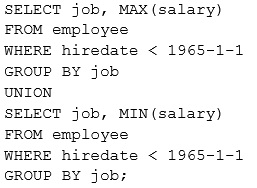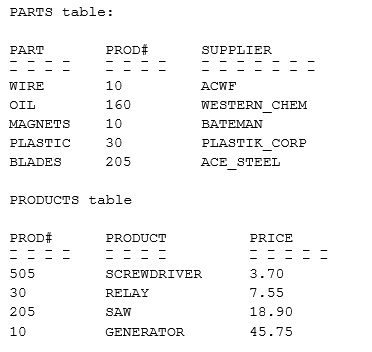DB2 11 Fundamentals for z/OS v1.0
Question 1
While DSN is running, which of the following commands CANNOT be successfully executed?
- A. ""STOP DB2
- B. ""START DB2
- C. ""TERM UTILITY
- D. ""DISPLAY UTILITY
Answer : D
Question 2
Which of the following is TRUE for using LOAD on a partition-by-growth table space?
- A. Data can only be loaded at the partition level
- B. Data can only be loaded at the table space level
- C. Data can only be loaded using a clustering index
- D. Data can be loaded at either the table space level or the partition level
Answer : A
Reference:
https://www.google.com/url?
sa=t&rct=j&q=&esrc=s&source=web&cd=1&cad=rja&uact=8&ved=0ahUKEwjXpIn74tzZAhVRPsAKHRYGBGUQFggnMAA&url=https%3A%2F%2Fwww.ibm.com
%2Fsupport%2Fknowledgecenter%2Fen%2FSSEPEK_11.0.0%2Fintro%2Fsrc%2Ftpc%
2Fdb2z_partitionbygrowthtablespaces.html&usg=AOvVaw0DCKeDA6MfIUE5UQWhFe_G
Question 3
Which of the following can be defined on the basis of a query?
- A. An alias
- B. A base table
- C. An accelerator-only table
- D. A materialized query table
Answer : D
Reference:
https://www.ibm.com/developerworks/data/library/techarticle/dm-0509melnyk/
Question 4
Assuming column hire date is a DATE data type, which SQL statement will retrieve the maximum salary (salary) and minimum salary(salary) for each job(job) from
EMPLOYEE table for those hired(hiredate) before 1965?

A.

B.

C.

D.
Answer : D
Question 5
In order to run a DB2 program, the user issues the following commands:
TSO prompt: READY -
USER enters: DSN SYS(SSTR)
USER enters: RUN PROGRAM(MYPROG)
USER enters: END -
What is the result?
- A. DB2 does not allow these commands
- B. DSN command can not be used to run a program
- C. Start a DSN session with DB2 subsystem SSTR, run a program and end the DSN session
- D. Start a DSN session with system parameters SSTR, run a program and end the DSN session
Answer : C
Reference:
https://www.ibm.com/support/knowledgecenter/en/SSEPEK_10.0.0/comref/src/tpc/db2z_cmd_dsn.html
Question 6
Which of the following describes OLTP workload rather than an analytics workload?
- A. Extreme data volume
- B. Temporary or intermediate staging of data
- C. Set-oriented processing and bulk operations
- D. A large number of short, discrete, atomic transactions
Answer : D
Reference:
http://www.ibmbigdatahub.com/sites/default/files/document/IBM-Netezza-Understanding-Analytic-Workloads-eBook.pdf
Question 7
Given the tables:

Which SQL statement would join the tables on product number (prod#) and provide a table of what products (product), if any, the parts (part) are used? Limit the result to only parts where suppliers (supplier) do not start with the letter A.

A.

B.

C.

D.
Answer : A
Question 8
Which of the following are advantages of DB2 for z/OS data sharing over a standalone DB2 subsystem implementation? (Choose two.)
- A. Reduced active logs
- B. Reduced storage use
- C. Higher transaction rates
- D. Reduced lock contention
- E. Increased data availability
Answer : CE
Question 9
The maximum size for each partition of a partition-by-range table space, with fewer than 255 partitions, is determined by which combination of options? (Choose two.)
- A. DSSIZE
- B. PRIQTY
- C. NUMPARTS
- D. BUFFERPOOL
- E. MAXPARTITIONS
Answer : AC
Reference:
https://www.ibm.com/support/knowledgecenter/en/SSEPEK_11.0.0/sqlref/src/tpc/db2z_sql_createtablespace.html
Question 10
Which of the following statements about a system-period temporal table is TRUE?
- A. Rows can be archived into a history table which is always read only
- B. Every row has a pair of timestamps which is set and managed by the application
- C. AN SQL query for auditing can be run against current data or history data, but not both
- D. The table contains only the current active rows
Answer : B
Explanation -
In a system-period temporal table, every row has a pair of timestamps, which are set by the DB2 system and recorded in the begin_column and end_column columns. DB2 uses the SYSTEM_TIME period to audit the data changes. It provides the application with the database managed row begin and row end timestamp maintenance, providing non-overlapping time periods with no gaps in time.
Reference:
https://www.ibm.com/developerworks/data/library/techarticle/dm-1410temporal-tables-db2zos/index.html
Question 11
Which types of user-defined data types are supported? (Choose two.)
- A. CHAR
- B. ARRAY
- C. NUMERIC
- D. DISTINCT
- E. TIMESTAMP
Answer : BD
Reference:
https://www.ibm.com/support/knowledgecenter/en/SSEPEK_11.0.0/sqlref/src/tpc/db2z_userdefineddatatypes.html
Question 12
Which BIND option determines when DB2 will do authorization checking?
- A. DEFER
- B. DEPLOY
- C. VALIDATE
- D. CURRENTDATA
Answer : C
Reference:
https://www.ibm.com/support/knowledgecenter/en/SSEPEK_10.0.0/comref/src/tpc/db2z_bindoptvalidate.html
Question 13
COL1 is defined as CHAR(05) and contains CHAR("˜12345"™). Which of the following expressions returns the digits 12345 for further calculation?
- A. HEX(COL1)
- B. DEC(COL1)
- C. PACK(COL1)
- D. DIGITS(COL1)
Answer : B
Question 14
Which DB2 address space manages DB2 locking?
- A. IRLM
- B. DIST
- C. DBM1
- D. MSTR
Answer : A
Reference:
https://www.ibm.com/support/knowledgecenter/en/SSEPEK_10.0.0/inst/src/tpc/db2z_irlmaddrspcstgreq.html
Question 15
What are two major encoding schemes? (Choose two.)
- A. UNIX
- B. Linux
- C. CCSID
- D. Unicode
- E. EBCDIC
Answer : DE
Reference:
https://www.ibm.com/support/knowledgecenter/en/SSEPEK_10.0.0/intro/src/tpc/db2z_introcodepage.html